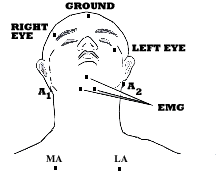888-503-2762
Hablamos Español
- Home
- •
- Telemedicine
- •
- DME Orders
- •
- Videos
- •
- SEC Non-Profit
- •
- Office Locations
- •



The technique for obtaining an EMG is harmless. Impulses are recorded by attaching small disk electrodes to the skin surface over the muscle. The electrode activity is evaluated during muscle contraction and at rest. Changes in the electrical wave forms allow the Polysomnographer to determine whether the muscle tone changes normally during the different sleep stages.
An EMG can reveal the presence of REM vs. NREM, and the Leg EMG can also reveal other pathologies such as Restless Leg Syndrome (RLS), or Periodic Leg Movements of Sleep (PLMS). Three leads are placed on the chin (one in the front and center and the other two underneath and on the jawbone) and two are placed on the inside of each calf muscle 2-4cm apart. Also a few electrodes are placed over the anterior tibialis on the legs. These leads serve to demonstrate muscle movement during sleep. This is helpful in documenting a wake period, an arousal, or just a spastic movement.
![]()